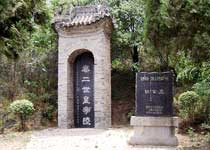Attration Category
Xi'an Weather

According to the historical record, in 207 B.C, the powerful minister Zhao Gao forced Hu Hai (the second emperor of Qin) to commit suicide, and buried him in zhou (a place name in the Qin Dynasty, and the concrete tomb is in today's Nanyuantai of Qujiangchi Village, Qujiang Town, Yanta District, Xi'an City, Shaanxi Province), and the tomb is usually called "Tomb of Hu Hai". The tomb, located in a sloping field, is hidden in a secluded and quiet place. It is round in shape, 25 meters in diameter and 5 meters in height. In north of the tomb stands a stone tablet, which is 3 meters high, 98 centimeters wide and 28 centimeters thick. The six large Chinese characters of "Qin Ershi Huangdi Ling (Tomb of Emperor Qin II)" in official script were carved in intaglio in the tablet surface, and the tablet was erected by Hua Yuan, the Provincial Governor of Shaanxi Province in the 41st year of the reign of Qianlong in the Qing Dynasty. Yeyishuo was carved in intaglio at the back of the tablet by the scholar Zhou Xinming in the 10th year of Emperor Jiaqing in the Qing Dynasty.
The site of the tomb is far more secluded than many of the city's other tourist attractions, with the ruins of an old home sitting out in front. Visitors can find the actual gravestone, as well as a few small exhibits. According to local caretakers the tomb is scheduled for a renovation in the near future.


